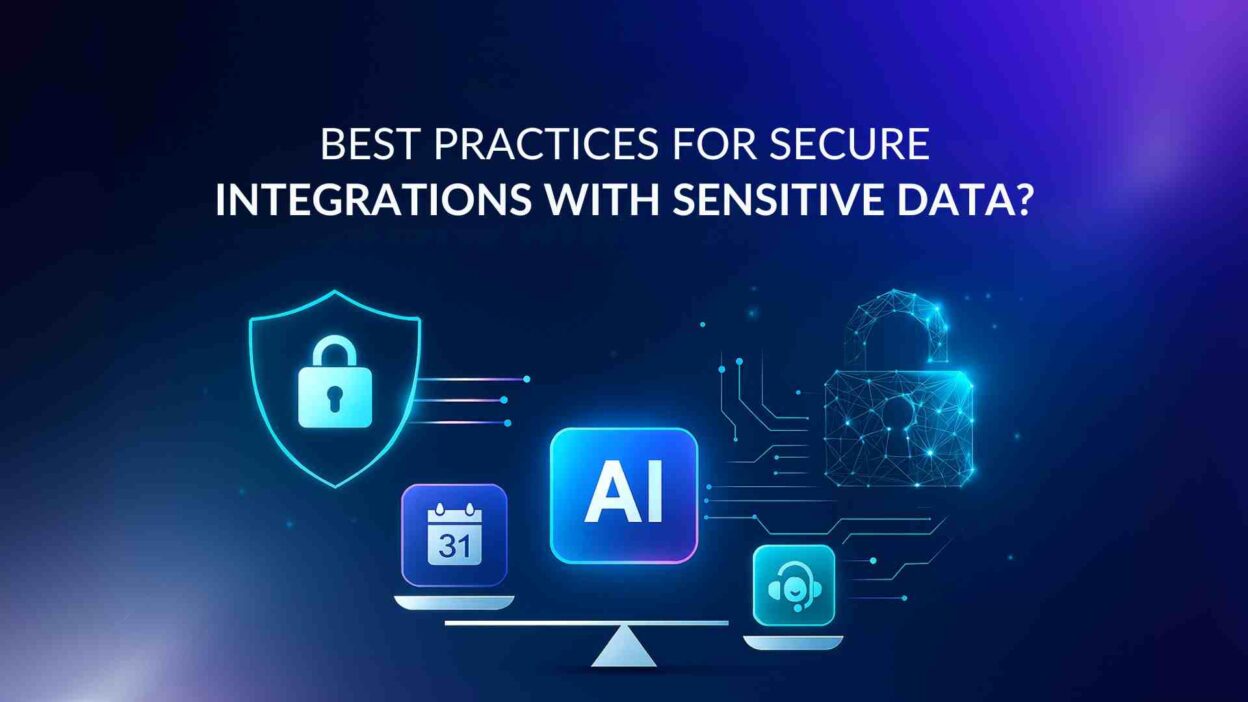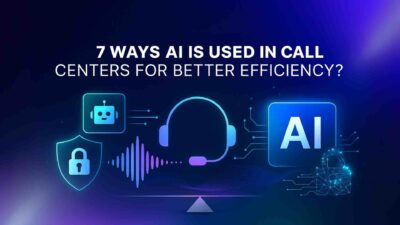TL;DR Data security has become a critical concern for businesses worldwide. Companies handle massive amounts of sensitive information daily through various systems and applications. The question “Are integrations secure for sensitive data?” keeps many IT professionals awake at night.
Table of Contents
Modern businesses rely heavily on software integrations to streamline operations. These connections between different systems create potential vulnerabilities if not properly secured. Understanding how to protect sensitive data during integration processes is essential for organizational success.
This comprehensive guide explores proven methods for maintaining data security during integrations. We’ll examine real-world scenarios and provide actionable strategies you can implement immediately. Your organization’s sensitive data deserves the highest level of protection available.
Understanding Data Integration Security Risks
Data integrations create pathways between different systems and applications. Each connection point represents a potential entry for malicious actors. Understanding these risks helps organizations make informed decisions about their integration security strategies.
Unsecured API endpoints pose significant threats to sensitive data. Hackers can exploit weak authentication mechanisms to gain unauthorized access. Many organizations underestimate the complexity of securing multiple integration points simultaneously.
Data transmission occurs across various networks during integration processes. Public networks and unsecured connections can expose sensitive information to interception. Man-in-the-middle attacks specifically target data moving between integrated systems.
Third-party services often require access to your sensitive data for integrations to function. These external providers may have different security standards than your organization. Vendor security practices directly impact your overall data protection strategy.
Legacy systems frequently lack modern security features required for safe integrations. Older applications may not support current encryption standards or authentication protocols. These outdated systems create weak links in your security chain.
Types of Sensitive Data in Integrations
Personal identifiable information requires the highest level of protection during integrations. Customer names, addresses, social security numbers, and phone numbers must remain secure. Regulatory compliance depends on proper handling of PII throughout integration processes.
Financial data represents another critical category requiring special security measures. Credit card numbers, bank account details, and transaction histories need robust protection. Payment processing integrations face strict industry standards and regular audits.
Healthcare information falls under specific regulatory requirements like HIPAA. Medical records, insurance details, and treatment information demand specialized security protocols. Healthcare integrations must maintain detailed audit trails and access controls.
Business-critical intellectual property requires careful protection during system integrations. Trade secrets, proprietary algorithms, and competitive information need secure handling. Industrial espionage often targets these valuable data types through integration vulnerabilities.
Employee records contain sensitive personal and professional information. Salary details, performance reviews, and background check results require secure integration practices. HR system integrations must comply with employment law requirements and privacy regulations.
Authentication and Authorization Best Practices
Multi-factor authentication provides essential security for integration access points. Username and password combinations alone offer insufficient protection for sensitive data. Modern authentication systems require multiple verification methods to confirm user identity.
API key management forms the foundation of secure integration and authentication. Unique keys for each integration prevent unauthorized access and enable detailed monitoring. Regular key rotation reduces the risk of compromised credentials affecting your systems.
OAuth 2.0 provides industry-standard authorization for third-party integrations. This protocol allows secure access delegation without sharing actual credentials. OAuth implementations require careful configuration to maintain security effectiveness.
Role-based access controls limit integration permissions to necessary functions only. Each integration should receive the minimum required privileges to complete its designated tasks. Excessive permissions create unnecessary security risks and compliance violations.
Session management controls how long integration connections remain active. Automatic timeouts prevent unauthorized access through abandoned sessions. Regular session validation ensures only legitimate connections remain active in your systems.
Token-based authentication offers superior security compared to traditional password systems. JWT tokens contain encrypted authorization information with built-in expiration dates. Proper token implementation includes signature validation and secure storage practices.
Encryption Standards for Data Protection
End-to-end encryption protects sensitive data throughout the entire integration process. Information remains encrypted from the source system to the destination application. This approach ensures data security even if transmission channels become compromised.
AES-256 encryption represents the current gold standard for data protection. This symmetric encryption algorithm provides excellent security with reasonable performance overhead. Government agencies and financial institutions rely on AES-256 for their most sensitive data.
Transport Layer Security secures data transmission between integrated systems. TLS 1.3 offers improved performance and security compared to earlier versions. All integration communications should use current TLS standards as a baseline requirement.
Database encryption protects sensitive information stored within integrated systems. Field-level encryption secures individual data elements while maintaining system functionality. This approach allows normal operations while protecting the most critical information.
Key management systems ensure encryption keys remain secure and properly rotated. Centralized key management simplifies administration while maintaining security standards. Hardware security modules provide additional protection for the most sensitive encryption keys.
Data masking techniques protect sensitive information during testing and development phases. Production data requires masking before use in non-production environments. This practice prevents accidental exposure of real customer information during integration development.
Network Security Considerations
Virtual Private Networks create secure tunnels for integrated communications. VPNs encrypt all traffic between integration endpoints regardless of underlying protocols. This approach provides comprehensive protection for data transmission across public networks.
Firewall configurations must account for integration traffic patterns and security requirements. Port restrictions limit access to only necessary communication channels. Network segmentation isolates integration traffic from general network communications.
Intrusion detection systems monitor network traffic for suspicious activity patterns. Real-time monitoring identifies potential security breaches before they cause significant damage. Automated response systems can block suspicious connections immediately.
Network access controls determine which systems can communicate with integration endpoints. IP whitelisting restricts connections to approved source addresses only. Geographic restrictions can block traffic from high-risk countries or regions.
Load balancing distributes integration traffic across multiple secure endpoints. This approach improves both performance and security by eliminating single points of failure. Redundant security measures ensure continued protection even during system outages.
DNS security prevents attackers from redirecting integration traffic to malicious endpoints. Secure DNS protocols verify endpoint authenticity before establishing connections. Regular DNS monitoring identifies suspicious domain resolution patterns.
API Security Implementation
Rate limiting prevents malicious actors from overwhelming your integration endpoints. Request throttling protects systems from both intentional attacks and accidental overload situations. Proper rate limiting maintains system availability while blocking suspicious activity patterns.
Input validation sanitizes all data received through integration APIs. Malicious payloads can exploit vulnerabilities in processing systems without proper validation. Comprehensive input checking prevents SQL injection and other common attack vectors.
Output filtering ensures sensitive data doesn’t leak through API responses. Response filtering removes unnecessary information that could aid potential attackers. This practice follows the principle of least information disclosure for security purposes.
API versioning allows security updates without breaking existing integrations. Deprecated API versions should include security warnings and migration timelines. Legacy API support requires ongoing security monitoring and regular vulnerability assessments.
Request signing verifies the authenticity and integrity of API communications. Digital signatures prevent tampering with integration requests during transmission. Signature validation ensures only authorized systems can make integration requests.
Error handling must balance user experience with security information disclosure. Detailed error messages can provide valuable information to potential attackers. Generic error responses prevent information leakage while still supporting legitimate troubleshooting efforts.
Compliance Framework Integration
GDPR compliance requires specific data protection measures for European customer information. Right to erasure capabilities must exist within all integration systems handling EU data. Data processing agreements need careful consideration for third-party integration providers.
HIPAA regulations mandate strict controls for healthcare information integrations. Business associate agreements must cover all integration vendors handling protected health information. Regular compliance audits verify continued adherence to healthcare privacy requirements.
PCI DSS standards govern integrations involving credit card and payment information. Cardholder data environments require special security controls and regular vulnerability scanning. Payment integrations must maintain detailed security documentation and undergo annual assessments.
SOX compliance affects integrations within publicly traded companies’ financial reporting systems. Internal controls must prevent unauthorized changes to financial data through integration channels. Audit trails must capture all integration activities affecting financial information.
Industry-specific regulations may impose additional requirements on integration security practices. Financial services face different standards than healthcare or retail organizations. Compliance frameworks should align with your organization’s specific regulatory environment.
Regular compliance assessments verify that integration security measures meet current regulatory standards. Third-party audits provide independent validation of your security practices. Compliance documentation must remain current and readily available for regulatory reviews.
Monitoring and Logging Strategies
Real-time monitoring identifies security threats as they occur within integration systems. Automated alerting notifies security teams of suspicious activity patterns immediately. Rapid response capabilities minimize potential damage from security incidents.
Comprehensive logging captures all integration activities for security analysis and compliance purposes. Log retention policies must balance storage costs with regulatory requirements. Centralized log management simplifies analysis and correlation across multiple systems.
Anomaly detection systems identify unusual patterns in integration traffic and data access. Machine learning algorithms can spot subtle indicators of potential security breaches. Behavioral analysis provides early warning of compromised accounts or systems.
Audit trails document all access to sensitive data through integration channels. User activity tracking enables forensic analysis following security incidents. Immutable log storage prevents attackers from covering their tracks after successful breaches.
Performance monitoring helps distinguish between legitimate traffic spikes and potential attacks. Resource utilization patterns can indicate distributed denial of service attempts. Integration performance baselines enable quick identification of unusual activity.
Security incident response procedures must include specific steps for integration-related breaches. Incident classification helps determine appropriate response escalation levels. Regular tabletop exercises test your team’s ability to respond to integration security incidents.
Third-Party Vendor Assessment
Vendor security assessments evaluate third-party integration providers’ security practices and capabilities. Due diligence processes must examine both technical security measures and organizational policies. Security questionnaires should cover all aspects of data handling and protection practices.
Contractual security requirements ensure vendors maintain appropriate protection levels for your sensitive data. Service level agreements must include specific security metrics and incident response timeframes. Penalty clauses provide financial incentives for maintaining agreed-upon security standards.
Regular vendor audits verify continued compliance with security requirements over time. Annual assessments may not catch emerging vulnerabilities or changing practices. Quarterly reviews provide better visibility into vendor security posture changes.
Vendor risk ratings help prioritize security oversight based on data sensitivity and exposure levels. High-risk integrations require more frequent monitoring and stricter security controls. Risk-based approaches optimize security resources while maintaining protection effectiveness.
Supply chain security extends vendor assessment to subcontractors and partners. Third-party providers may rely on additional vendors for integration services. Understanding the complete supply chain helps identify all potential security risks.
Vendor termination procedures must include secure data return or destruction requirements. Integration decommissioning should remove all access to your sensitive information. Clear data handling requirements prevent unauthorized retention after contract termination.
Incident Response Planning
Integration-specific incident response plans address the unique challenges of distributed security events. Incidents may span multiple systems and vendors, requiring coordinated response efforts. Clear communication channels ensure all stakeholders receive timely incident notifications.
Incident classification systems help determine appropriate response escalation levels for integration security events. Data breach incidents require different responses than system availability issues. Classification criteria should align with regulatory notification requirements and business impact assessments.
Communication protocols ensure all relevant parties receive appropriate incident information. Customer notifications may be required for certain types of data breaches. Legal and regulatory reporting obligations must be clearly defined and understood.
Forensic capabilities enable detailed analysis of integration security incidents after they occur. Digital evidence collection requires specialized tools and procedures for distributed systems. Chain of custody documentation ensures evidence remains admissible for legal proceedings.
Recovery procedures restore normal operations while maintaining security integrity. System restoration must include verification of security controls and data integrity. Post-incident security hardening prevents similar future attacks.
Lessons learned processes improve incident response capabilities based on experience. After-action reviews identify gaps in procedures and training requirements. Regular plan updates incorporate new threats and organizational changes.
Regular Security Assessments
Vulnerability scanning identifies potential security weaknesses in integration systems and configurations. Automated scanning tools can detect known vulnerabilities and misconfigurations across multiple systems. Manual testing supplements automated tools for complex integration scenarios.
Penetration testing simulates real-world attacks against integration security controls. Ethical hackers attempt to exploit vulnerabilities using actual attack techniques. Pen testing results provide concrete evidence of security control effectiveness.
Security architecture reviews examine integration designs for potential security flaws. Design reviews should occur before implementation to prevent costly security retrofitting. Regular architecture assessments identify emerging risks from system changes or new threats.
Code reviews examine integration applications for security vulnerabilities and coding errors. Static code analysis tools can identify common security flaws automatically. Manual code reviews by security experts catch logic flaws and design issues.
Configuration audits verify security settings remain properly configured across all integration components. System hardening standards should be regularly validated and updated. Configuration drift can introduce vulnerabilities over time without proper monitoring.
Risk assessments evaluate the overall security posture of integration environments. Quantitative risk analysis helps prioritize security investments and improvements. Regular risk updates account for changing threat landscapes and business requirements.
Data Loss Prevention Techniques
Data classification systems identify sensitive information requiring special protection during integrations. Automated classification tools can scan data streams and storage systems for sensitive content. Classification labels drive appropriate security controls and handling procedures.
Content filtering prevents sensitive data from leaving authorized systems through integration channels. Data loss prevention tools monitor integration traffic for sensitive information patterns. Real-time blocking prevents unauthorized data transmission while alerting security teams.
Watermarking techniques enable tracking of sensitive documents and data through integration processes. Digital watermarks can identify the source and authorized recipients of sensitive information. Watermark detection helps trace data leaks back to specific integration points.
Data retention policies govern how long sensitive information remains available through integration systems. Automated purging removes outdated sensitive data according to regulatory and business requirements. Retention schedules must balance operational needs with security risk reduction.
Backup encryption protects sensitive data copies created during integration processes. Integration systems may create temporary copies for processing or error recovery. All data copies require the same security protections as primary data stores.
Secure deletion ensures sensitive data removal when no longer needed by integration systems. Standard file deletion may not completely remove sensitive information from storage media. Secure deletion tools overwrite sensitive data to prevent recovery by unauthorized parties.
Future-Proofing Security Measures
Emerging threat intelligence helps organizations prepare for new attack vectors targeting integration systems. Threat landscape monitoring identifies evolving risks before they affect your environment. Security controls must adapt to address new attack techniques and vulnerabilities.
Security automation reduces human error while improving response times to integration security events. Automated security controls can respond to threats faster than manual processes. Machine learning enhances automation capabilities through pattern recognition and predictive analysis.
Zero-trust architecture assumes no system or user can be inherently trusted within integration environments. Every access request requires verification regardless of source location or previous authentication. Zero-trust principles minimize damage from compromised accounts or systems.
Quantum-resistant encryption prepares for future threats from quantum computing advances. Current encryption algorithms may become vulnerable to quantum computer attacks. Migration planning ensures smooth transitions to quantum-resistant security algorithms.
Cloud security evolution requires adaptation of integration security practices for cloud-native architectures. Container security, serverless computing, and microservices present new integration security challenges. Security controls must evolve to address cloud-specific risks and capabilities.
Artificial intelligence integration creates new opportunities for both security enhancement and attack vectors. AI-powered security tools can identify sophisticated threats more effectively than traditional approaches. Security teams must understand AI capabilities and limitations for integration protection.
Read More: Adding AI to Software with API Integration
Conclusion

Securing integrations with sensitive data requires comprehensive planning and ongoing vigilance from organizations. The question “Are integrations secure for sensitive data?” depends entirely on implementation quality and security practices. Proper authentication, encryption, and monitoring create robust protection for sensitive information.
Organizations must balance security requirements with operational efficiency when designing integration architectures. Overly restrictive security controls can hamper business operations while insufficient protection exposes sensitive data to unnecessary risks. The key lies in implementing appropriate security measures based on data sensitivity and risk assessment.
Regular security assessments and updates ensure integration protection remains effective against evolving threats. Cybersecurity landscapes change rapidly, requiring adaptive security strategies and continuous improvement efforts. Organizations that prioritize integration security will maintain competitive advantages while protecting stakeholder trust.
Compliance frameworks provide valuable guidance for integration security, but should not be considered sufficient alone. Industry standards represent minimum requirements rather than comprehensive security strategies. Organizations must exceed basic compliance requirements to achieve truly secure integration environments.





